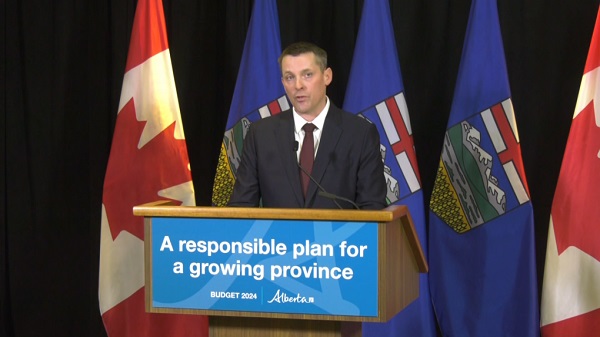Alberta
Alberta 2025 Budget Review from the Alberta Institute

The government has just tabled its budget in the Legislature.
We were invited to the government’s advance briefing, which gave us a few hours to review the documents, ask questions, and analyze the numbers before the official release.
Now that the embargo has been lifted, we can share our thoughts with you.
However, this is just our preliminary analysis – we’ll have a more in-depth breakdown for you next week.
*****
The 2025/26 Budget is a projection for the next year – what the government expects will happen from April 1st, 2025 to March 31st, 2026.
It represents the government’s best estimate of future revenue and its plan for expenditures.
In the budget (and in this email) this type of figure is referred to as a Budget figure.
*****
The actual final figures won’t be known until the 2025/26 Annual Report is released in the middle of next year.
Of course, as we’ve seen in the past, things don’t always go according to plan.
In the budget (and in this email) this type of figure is referred to as an Actual figure.
Importantly, this means that the 2024/25 Annual Report isn’t ready yet, either.
*****
Therefore, in the meantime, the Q3 2025/26 Fiscal Update, which has figures up to December 31st, 2024, provides a forecast for the 2024/25 year.
The government looks at the actual results three quarters of the way through the previous year, and uses those figures to get the most accurate forecast on what will be the final result in the annual report, to help with estimating the 2025-26 year.
In the budget (and in this email) this type of figure is referred to as a Forecast figure.
*****
Accurately estimating, and tracking these three types of figures is a key part of good budgeting.
Sometimes, the economy performs better than expected, oil prices could be higher than initially forecast, or more revenue may come in from other sources.
But, other times, there’s a recession or a drop in oil prices, leading to lower-than-expected revenue.
On the spending side, governments sometimes find savings, keeping expenses lower than planned.
Alternatively, unexpected costs, disasters, or just governments being governments can also drive spending higher than budgeted.
The best way to manage this uncertainty is:
- Be conservative in estimating revenue.
- Only plan to spend what is reasonably expected to come in.
- Stick to that spending plan to avoid overspending.
By following these principles, the risk of an unexpected deficit is minimized.
And if revenue exceeds expectations or expenses come in lower, the surplus can be used to pay down debt or be returned to taxpayers.
On these three measures, this year’s budget gets a mixed grade.
*****
On the first point, the government has indeed made some pretty conservative estimates of revenue – including assuming an oil price several dollars below where it currently stands, and well below the previous year’s predictions.
The government has also assumed there will be some significant (though not catastrophic) effects from a potential trade war.
If oil prices end up higher, or Canada avoids a trade war with the US, then revenue could be significantly higher than planned.
Interestingly, this year’s budget looks very different depending on whether you compare it to last year’s budget, or the latest forecast.
This year’s budget revenue is $6.6 billion lower than what actually happened in last year’s forecast revenue.
But, this year’s budget revenue is actually $600 million higher than what was expected to happen in last year’s budget revenue.
In other words, if you compare this year’s budget to what the government expected to happen last year, revenue is up a small amount, but when you compare this year’s budget to what actually happened last year, revenue is down a lot.
*****
On the second point, unfortunately, the government doesn’t score so well.
Expenses are up quite a bit, even though revenue is expected to drop.
According to some measurements, expenditures are increasing slower than the combined rate of population growth and inflation – which is the goal the government set for itself in 2023.
But, when other expenses like contingencies for emergencies are included, or when expenses are measured in other ways, spending is increasing faster than that benchmark.
This year’s budget expenses are $4.4 billion higher than what was actually spent in last year’s forecast expenses.
But, this year’s budget expenses are $6.1 billion higher than what was expected to happen in last year’s budget expenses.
Perhaps the bigger question is why is expenditure increasing at all when revenue is expected to drop?
If there’s less money coming in, the government should really be using this as an opportunity to reduce overall expenditures.
*****
On the third point, we will – of course – have to wait and see what the final accounts look like next year!
*****
Before we wrap up this initial analysis, there’s one aspect of the budget that is likely to receive significant attention, and that is a tax cut.
Originally planned to be phased in over the next few years, a tax cut will now be back-dated to January 1st of this year.
Previously, any income below about $150,000 was subject to a 10% provincial tax, while incomes above $150,000 attract higher and higher tax rates of 12%, 13%, 14%, and 15% as incomes increase.
Under the new tax plan, incomes under $60,000 would only be taxed at 8%, with incomes between $60,000 and $150,000 still paying 10%, and incomes above $150,000 still paying 12%, 13%, 14%, and 15%, as before.
Some commentators are likely to question the wisdom of a tax cut that reduces revenue when the budget is going to be in deficit.
But, the reality is that this tax cut doesn’t actually cost much.
We’ll have the exact figures for you by next week, but suffice to say that it’s a pretty small portion of the overall deficit, and there’s a deficit because spending is up a lot, not because of a small tax cut.
In general, lower taxes are good, but we would have preferred the government work towards a lower, flatter tax instead.
The Alberta Advantage was built on Alberta’s unique flat tax system where everyone paid the same low flat tax (not the same amount, the same percentage!) and so wasn’t punished for succeeding.
Alberta needs a plan to get back to a low flat tax, and we will continue to advocate for this at the Alberta Institute.
Maybe we can do better than just returning to the old 10% flat tax, though?
Maybe we should aim for a flat tax of 8%, instead?
That’s it for today’s quick initial analysis.
In next week’s analysis, we’ll break down the pros and cons of these decisions and outline where we might have taken a different approach.
In the meantime, if you appreciate our work and want to support more of this kind of independent analysis of Alberta’s finances, please consider making a donation here:
Alberta
Low oil prices could have big consequences for Alberta’s finances

From the Fraser Institute
By Tegan Hill
Amid the tariff war, the price of West Texas Intermediate oil—a common benchmark—recently dropped below US$60 per barrel. Given every $1 drop in oil prices is an estimated $750 million hit to provincial revenues, if oil prices remain low for long, there could be big implications for Alberta’s budget.
The Smith government already projects a $5.2 billion budget deficit in 2025/26 with continued deficits over the following two years. This year’s deficit is based on oil prices averaging US$68.00 per barrel. While the budget does include a $4 billion “contingency” for unforeseen events, given the economic and fiscal impact of Trump’s tariffs, it could quickly be eaten up.
Budget deficits come with costs for Albertans, who will already pay a projected $600 each in provincial government debt interest in 2025/26. That’s money that could have gone towards health care and education, or even tax relief.
Unfortunately, this is all part of the resource revenue rollercoaster that’s are all too familiar to Albertans.
Resource revenue (including oil and gas royalties) is inherently volatile. In the last 10 years alone, it has been as high as $25.2 billion in 2022/23 and as low as $2.8 billion in 2015/16. The provincial government typically enjoys budget surpluses—and increases government spending—when oil prices and resource revenue is relatively high, but is thrown into deficits when resource revenues inevitably fall.
Fortunately, the Smith government can mitigate this volatility.
The key is limiting the level of resource revenue included in the budget to a set stable amount. Any resource revenue above that stable amount is automatically saved in a rainy-day fund to be withdrawn to maintain that stable amount in the budget during years of relatively low resource revenue. The logic is simple: save during the good times so you can weather the storm during bad times.
Indeed, if the Smith government had created a rainy-day account in 2023, for example, it could have already built up a sizeable fund to help stabilize the budget when resource revenue declines. While the Smith government has deposited some money in the Heritage Fund in recent years, it has not created a dedicated rainy-day account or introduced a similar mechanism to help stabilize provincial finances.
Limiting the amount of resource revenue in the budget, particularly during times of relatively high resource revenue, also tempers demand for higher spending, which is only fiscally sustainable with permanently high resource revenues. In other words, if the government creates a rainy-day account, spending would become more closely align with stable ongoing levels of revenue.
And it’s not too late. To end the boom-bust cycle and finally help stabilize provincial finances, the Smith government should create a rainy-day account.
Alberta
Governments in Alberta should spur homebuilding amid population explosion

From the Fraser Institute
By Tegan Hill and Austin Thompson
In 2024, construction started on 47,827 housing units—the most since 48,336 units in 2007 when population growth was less than half of what it was in 2024.
Alberta has long been viewed as an oasis in Canada’s overheated housing market—a refuge for Canadians priced out of high-cost centres such as Vancouver and Toronto. But the oasis is starting to dry up. House prices and rents in the province have spiked by about one-third since the start of the pandemic. According to a recent Maru poll, more than 70 per cent of Calgarians and Edmontonians doubt they will ever be able to afford a home in their city. Which raises the question: how much longer can this go on?
Alberta’s housing affordability problem reflects a simple reality—not enough homes have been built to accommodate the province’s growing population. The result? More Albertans competing for the same homes and rental units, pushing prices higher.
Population growth has always been volatile in Alberta, but the recent surge, fuelled by record levels of immigration, is unprecedented. Alberta has set new population growth records every year since 2022, culminating in the largest-ever increase of 186,704 new residents in 2024—nearly 70 per cent more than the largest pre-pandemic increase in 2013.
Homebuilding has increased, but not enough to keep pace with the rise in population. In 2024, construction started on 47,827 housing units—the most since 48,336 units in 2007 when population growth was less than half of what it was in 2024.
Moreover, from 1972 to 2019, Alberta added 2.1 new residents (on average) for every housing unit started compared to 3.9 new residents for every housing unit started in 2024. Put differently, today nearly twice as many new residents are potentially competing for each new home compared to historical norms.
While Alberta attracts more Canadians from other provinces than any other province, federal immigration and residency policies drive Alberta’s population growth. So while the provincial government has little control over its population growth, provincial and municipal governments can affect the pace of homebuilding.
For example, recent provincial amendments to the city charters in Calgary and Edmonton have helped standardize building codes, which should minimize cost and complexity for builders who operate across different jurisdictions. Municipal zoning reforms in Calgary, Edmonton and Red Deer have made it easier to build higher-density housing, and Lethbridge and Medicine Hat may soon follow suit. These changes should make it easier and faster to build homes, helping Alberta maintain some of the least restrictive building rules and quickest approval timelines in Canada.
There is, however, room for improvement. Policymakers at both the provincial and municipal level should streamline rules for building, reduce regulatory uncertainty and development costs, and shorten timelines for permit approvals. Calgary, for instance, imposes fees on developers to fund a wide array of public infrastructure—including roads, sewers, libraries, even buses—while Edmonton currently only imposes fees to fund the construction of new firehalls.
It’s difficult to say how long Alberta’s housing affordability woes will endure, but the situation is unlikely to improve unless homebuilding increases, spurred by government policies that facilitate more development.
-

 2025 Federal Election17 hours ago
2025 Federal Election17 hours agoNine Dead After SUV Plows Into Vancouver Festival Crowd, Raising Election-Eve Concerns Over Public Safety
-

 2025 Federal Election14 hours ago
2025 Federal Election14 hours agoMark Carney: Our Number-One Alberta Separatist
-

 Opinion1 day ago
Opinion1 day agoCanadians Must Turn Out in Historic Numbers—Following Taiwan’s Example to Defeat PRC Election Interference
-

 International2 days ago
International2 days agoHistory in the making? Trump, Zelensky hold meeting about Ukraine war in Vatican ahead of Francis’ funeral
-

 C2C Journal1 day ago
C2C Journal1 day ago“Freedom of Expression Should Win Every Time”: In Conversation with Freedom Convoy Trial Lawyer Lawrence Greenspon
-

 International18 hours ago
International18 hours agoJeffrey Epstein accuser Virginia Giuffre reportedly dies by suicide
-

 2025 Federal Election18 hours ago
2025 Federal Election18 hours agoColumnist warns Carney Liberals will consider a home equity tax on primary residences
-

 2025 Federal Election2 days ago
2025 Federal Election2 days agoCarney’s budget is worse than Trudeau’s




